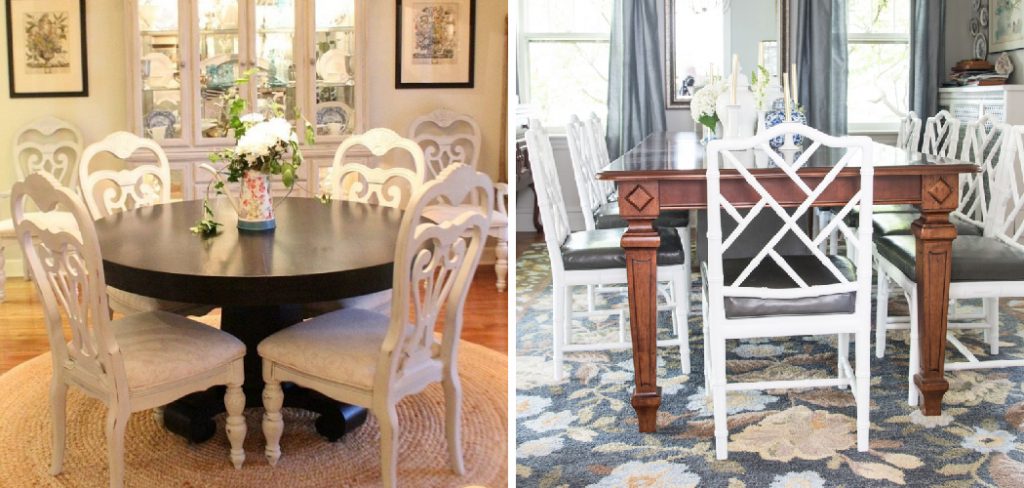Painting dining chairs can transform your dining room, giving it a fresh, personalized look without the expense of purchasing new furniture. Whether you’re aiming to update a thrifted set, coordinate mismatched chairs, or simply inject some new life into your space, the process of painting dining chairs is a rewarding DIY project.
It allows you to customize the color, finish, and overall aesthetic to perfectly suit your style. This guide will walk you through each step of how to paint dining chairs, from selecting the right paint and preparing the chairs to applying the paint and ensuring a durable finish.

With a few tools, some patience, and a bit of creativity, you can achieve a professional-looking result that revitalizes your dining area. Whether you prefer a sleek, modern look or a more rustic, distressed finish, painting your dining chairs can be a fun and satisfying way to express your personal style and enhance your home’s ambiance.
The Importance of Dining Chairs
Dining chairs are more than just functional furniture; they are essential components that contribute to the overall aesthetic and comfort of your dining space. High-quality, well-designed dining chairs provide the necessary support for extended periods of sitting, ensuring that your dining experiences are comfortable and enjoyable. Moreover, dining chairs play a crucial role in setting the tone and style of your dining area.
They can either harmonize with your existing décor or serve as statement pieces that add character and flair. Whether you have a contemporary setup or a more traditional arrangement, the right dining chairs elevate the room’s ambiance and make mealtimes more inviting. Additionally, sturdy and durable dining chairs represent a wise investment, offering longevity and reducing the need for frequent replacements. Their importance spans both practical and aesthetic dimensions, making them a key element in creating a cohesive and welcoming dining environment.
Benefits of Painting Dining Chairs
Painting dining chairs offers a host of benefits, making it a popular choice for homeowners looking to refresh their space. One of the primary advantages is cost-effectiveness; instead of spending a considerable sum on new chairs, a fresh coat of paint can provide a brand-new look at a fraction of the price. This project also allows for immense creative freedom, enabling you to choose colors and finishes that perfectly align with your aesthetic preferences and existing décor.
Additionally, painting is an excellent way to extend the life of older or worn-out chairs, reinforcing their surfaces and protecting them from further wear and tear. By painting your dining chairs, you can seamlessly coordinate mismatched sets, creating a harmonious and cohesive look in your dining area.
Furthermore, engaging in a DIY painting project can be highly satisfying, allowing you to take pride in a customized, personal touch that enhances your home. The process is not only practical but also a fulfilling way to contribute to the unique character of your dining space.
Assessing Your Dining Chairs
Before you begin the process of painting your dining chairs, it’s essential to thoroughly assess their current condition. Start by examining each chair for any structural issues such as loose joints, cracks, or broken parts. Address these problems by gluing, clamping, or replacing damaged pieces to ensure your chairs are sturdy and safe for use.

Next, inspect the surface of the chairs for any existing finishes such as varnish, paint, or stains. Removing these finishes is crucial for achieving a smooth and even application of your new paint. Additionally, take note of any dents, scratches, or imperfections that may need sanding or filling.
By carefully assessing the state of your dining chairs, you can determine the necessary repairs and preparations, setting a solid foundation for a successful painting project. This meticulous approach will not only enhance the durability of your chairs but also contribute to a polished and professional final result.
Evaluating the Current Condition
Evaluating the current condition of your dining chairs is a crucial step in the painting process that ensures successful results. Start by placing each chair on a sturdy, flat surface for a comprehensive inspection. Look closely at the joints and legs to ensure they are stable and free from damage. Wiggle the chair gently to check for any wobbling or instability, which could indicate loose joints that need to be tightened or glued.
After confirming the structural integrity, focus on the surface of the chairs. Identify areas with chipped paint, worn finishes, or rough textures that will require sanding. Also, note any deep scratches or gouges that may need to be filled with wood filler.
Removing any old finishes or varnish is essential for proper paint adhesion, so assess whether the existing surface will require stripping. By thoroughly evaluating your dining chairs, you can create a detailed plan for the necessary repairs and preparations, ensuring a smooth painting process and long-lasting results.
Determination of the Desired Color Scheme and Style
Selecting the ideal color scheme and style for your dining chairs is a pivotal stage in the painting process, as it will influence the overall aesthetic of your dining space. Begin by considering the existing décor and color palette of your dining area to ensure harmony and cohesion.

If your dining room features neutral tones, you might opt for bold, contrasting colors to make the chairs stand out as focal points. Conversely, if your space is already vibrant, selecting complementary or harmonious hues can help create a balanced look.
In addition to color, the finish of the paint will significantly impact the final appearance. A high-gloss finish can give your chairs a sleek, modern look, whereas a matte or satin finish might be better suited for a more understated or rustic style. Considering textures and patterns is also important. Techniques such as distressing, chalk painting, or adding decorative stencils can add character and uniqueness to your chairs.
Finally, think about the overall vibe you wish to convey—whether it’s cozy and traditional, chic and contemporary, or eclectic and artistic. Collect inspiration from interior design magazines, online platforms like Pinterest, or even your favorite furniture stores. By thoughtfully determining your desired color scheme and style, you can ensure that your painted dining chairs will enhance your space’s ambiance and reflect your personal taste.
Preparing the Chairs for Painting
Proper preparation of your dining chairs is key to achieving a professional and long-lasting paint finish. Begin by cleaning the chairs thoroughly to remove any dust, grease, or grime. Use a mixture of warm water and mild detergent, scrubbing the surfaces with a sponge or soft brush. Pay special attention to areas that may have accumulated dirt over time, such as the legs and joints. Once the chairs are clean, wipe them down with a damp cloth to remove any soap residue, and let them dry completely.
Next, remove any old finish or varnish to provide a smooth base for the new paint. Use sandpaper with a medium grit (around 120-150 grit) to sand the entire surface of the chairs. This will help to remove old layers of paint or varnish and create a texture that allows the new paint to adhere better. For intricate or detailed areas, you may need to use a sanding sponge or sandpaper sheets folded to fit small spaces. Once the sanding is complete, wipe down the chairs with a tack cloth to remove any dust particles.
After sanding, it’s important to address any imperfections in the wood. Fill any deep scratches, dents, or gaps with wood filler, following the manufacturer’s instructions. Allow the filler to dry completely before sanding it smooth with fine-grit sandpaper (around 220 grit). This will ensure that the surface of the chairs is even and ready for priming.
Priming the chairs is a crucial step that will help the paint adhere better and provide a uniform finish. Choose a high-quality primer suitable for the type of paint you plan to use. Apply the primer evenly with a brush or roller, making sure to cover all surfaces. If the primer reveals any remaining imperfections, sand them lightly and apply an additional coat of primer if necessary. Allow the primer to dry completely before moving on to the painting stage.
By following these steps and carefully preparing your chairs, you can ensure that your painting project will yield beautiful, durable results that enhance the overall look of your dining area.

10 Methods How to Paint Dining Chairs
Method 1: Prepping the Chairs
Before you begin painting, it’s essential to properly prep your dining chairs. Start by removing any cushions or upholstery, as well as any detachable parts like arms or legs if possible. Clean the chairs thoroughly with a mixture of water and mild detergent to remove any dirt, grease, or grime.
Once clean, lightly sand the chairs with a fine-grit sandpaper (220-grit works well) to scuff up the surface and help the paint adhere better. Wipe away any dust with a tack cloth or damp rag. Proper prep work ensures a smooth and long-lasting finish.
Method 2: Choosing the Right Paint
Selecting the right type of paint is crucial for a durable and attractive finish. For dining chairs, a high-quality latex or chalk paint is often the best choice. Latex paint is durable and easy to clean, making it ideal for furniture that gets frequent use. Chalk paint, on the other hand, offers a matte finish and is excellent for creating a vintage or shabby chic look. Regardless of the type, choose a paint with a durable finish that can withstand daily wear and tear.
When it comes to color, the options are endless. You can opt for a bold and vibrant hue to make a statement, or go for a subtle and neutral tone that complements your existing decor. Whichever color you choose, consider using sample paints on a small area of the chair first to see how it looks in different lighting before committing to painting all of the chairs.
Method 3: Priming the Chairs
Priming the chairs before painting is essential, especially if the chairs are dark or have a glossy finish. A good primer helps the paint adhere better and ensures a more uniform color. Apply a coat of high-quality primer using a brush or roller, ensuring all surfaces are covered. Allow the primer to dry completely according to the manufacturer’s instructions. For the best results, lightly sand the primed surfaces with fine-grit sandpaper and wipe away any dust before proceeding to paint.
Priming not only helps with paint adhesion, but it also seals any imperfections in the wood such as knots or cracks. This prevents them from showing through the final coat of paint and provides a smooth and professional-looking finish.

Method 4: Using Spray Paint
Spray painting can be an efficient and effective way to achieve a smooth, even finish on dining chairs. Choose a high-quality spray paint specifically designed for furniture, and work in a well-ventilated area or outdoors. Shake the can well and apply the paint in light, even coats, keeping the can about 12 inches away from the surface. Allow each coat to dry thoroughly before applying the next. Spray painting can save time and provide a professional-looking finish, especially on intricate chair designs. However, it is important to practice proper safety measures and cover nearby surfaces to avoid overspray.
Method 5: Brushing on Paint
If you prefer the control and precision of using a brush, opt for a high-quality synthetic brush for latex paint or a natural bristle brush for chalk paint. Apply the paint in thin, even coats, following the grain of the wood. Use long, smooth strokes to minimize brush marks and ensure an even finish. Allow each coat to dry completely before applying additional coats. Typically, two to three coats of paint are sufficient for full coverage. Brushing on paint allows for detailed work and is ideal for chairs with intricate carvings or designs.
Method 6: Creating a Distressed Look
For a vintage or shabby chic look, consider distressing your painted dining chairs. Start by painting the chairs with a base coat of chalk paint in your desired color. Once the paint is dry, use fine-grit sandpaper to gently sand the edges, corners, and other areas where natural wear would occur. This technique reveals the underlying wood or primer, giving the chairs a weathered, aged appearance. Finish with a clear wax or polyurethane to protect the distressed finish. Distressing adds character and charm to your dining chairs, making them unique statement pieces.

Method 7: Using Stencils and Patterns
Adding stencils or patterns to your dining chairs can elevate their appearance and add a touch of personality. After painting the chairs with a base color, choose a stencil or pattern that complements your décor. Secure the stencil to the chair using painter’s tape, and apply a contrasting paint color using a stencil brush or sponge. Apply the paint in a dabbing motion to prevent bleed-through. Carefully remove the stencil and allow the paint to dry completely. Stenciling adds a decorative element to your chairs, making them truly one-of-a-kind.
Method 8: Applying a Protective Topcoat
To ensure your painted dining chairs are durable and easy to clean, it’s essential to apply a protective topcoat. For latex paint, a water-based polyurethane provides a clear, durable finish. For chalk paint, use a clear wax or a specialized chalk paint sealer.
Apply the topcoat using a brush or a clean, lint-free cloth, following the manufacturer’s instructions. Allow the topcoat to dry completely before using the chairs. A protective topcoat enhances the durability of the paint and keeps your chairs looking beautiful for years to come.

Method 9: Adding Decorative Accents
Enhancing your painted dining chairs with decorative accents can add a touch of elegance and sophistication. Consider adding metallic accents using gold or silver leaf, or applying a contrasting paint color to details like spindles or chair backs.
You can also use decorative decals or appliqués to add intricate designs without the need for stencils. Adding decorative accents allows you to customize your chairs to match your style and create a cohesive look in your dining room.
Method 10: Upholstering the Seats
If your dining chairs have upholstered seats, consider reupholstering them to complement the new paint color. Choose a fabric that matches or contrasts with the painted finish, and use a staple gun to attach the fabric to the seat.
Ensure the fabric is pulled tight and secured evenly to prevent wrinkles. Reupholstering the seats not only enhances the overall appearance of the chairs but also provides an opportunity to add comfort and style to your dining area.

Conclusion
Painting dining chairs is a rewarding DIY project that can transform the look of your dining room and give old furniture a new lease on life. By following these ten elaborated methods, you can achieve a professional-looking finish and ensure your chairs are both beautiful and durable.
From choosing the right paint and prepping the chairs to adding decorative accents and reupholstering seats, each step is essential to achieving the best results. Hopefully, this article gave you some helpful tips about how to paint dining chairs successfully, so now that you have the proper knowledge on how to get the job done, why not give it a try today?
About the Author
Adrian Green, a lifelong woodworking enthusiast, shares his passion for the craft through The Woodenify Blog. With a foundation built on years of hands-on experience in his father’s woodworking shop, Adrian is dedicated to helping others learn and grow in the world of DIY woodworking. His approach to woodworking combines creativity, practicality, and a deep appreciation for the art of building with your own hands. Through his blog, he inspires individuals of all skill levels to embark on their own woodworking journeys, creating beautiful, functional pieces of furniture and décor.
Professional Focus
- Specializes in DIY woodworking projects, from furniture to home décor.
- Provides step-by-step guides and practical tutorials for woodworkers of all skill levels.
- Dedicated to helping readers build confidence and skill through easy-to-follow instructions and tips.
- Passionate about fostering a community of makers who can share, learn, and grow together.
Education History
- University of Craft and Design – Bachelor of Fine Arts (BFA) in Woodworking and Furniture Design
- Woodworking Apprenticeships – Extensive hands-on training with skilled craftsmen to refine carpentry and furniture making techniques.
- Online Courses & Masterclasses – Continued education in advanced woodworking techniques, design principles, and specialized tools
Expertise:
- DIY woodworking, carpentry, furniture making, and home décor projects.
- Creating accessible tutorials and guides for beginner to advanced woodworkers.
- Sharing the joys and satisfaction of woodworking, from raw materials to finished products.
